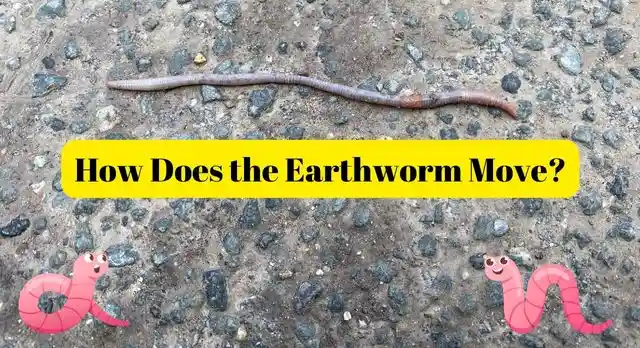How Does the Earthworm Move? It’s Fascinating Locomotion
The humble earthworm, a seemingly ordinary creature, plays a crucial role in our ecosystem. These unassuming organisms, also known as Lumbricus terrestris, silently contribute to soil health and fertility while exhibiting a remarkable mode of locomotion. In this article, we will delve into the intricate details of how earthworms move, unveiling the secrets behind their fascinating locomotion.
Evolutionary Journey of Earthworm Movement
Over millions of years, earthworms have evolved to become efficient burrowers, essential to the ecosystem’s functioning. The following features contribute to their successful locomotion:
- Segmented Body: Earthworms have a segmented body with each segment containing muscle fibers that enable their movement. These circular and longitudinal muscles work in coordination, allowing the earthworm to extend and contract its body.
- Hydrostatic Skeleton: Unlike vertebrates with internal skeletons, earthworms possess a hydrostatic skeleton. It is essentially a fluid-filled cavity within their body, giving them the necessary support to maintain their shape. By changing the fluid pressure in different segments, they can extend and retract.
- Setae for Anchorage: Each segment of an earthworm (except the first and last) is equipped with tiny bristle-like structures called setae. When the circular muscles contract, the setae anchor into the surrounding soil, preventing backward slippage as the longitudinal muscles push the worm forward.

Modes of Earthworm Locomotion
Earthworms employ three primary modes of movement to navigate through their underground habitat:
- Peristaltic Movement
Peristaltic movement is the most common mode of earthworm locomotion. In this method, the worm alternates between elongating and contracting its body segments. It begins by extending the front part of its body, using setae for anchorage. Then, the posterior part of the body follows suit. This sequential elongation and contraction push the earthworm forward in a wave-like motion.
- Serpentine Movement
The serpentine movement is less frequent but equally intriguing. Earthworms employ this mode of locomotion when faced with obstacles or tight spaces. Instead of extending their bodies in a linear manner, they adopt an S-shaped curve. The worm then thrusts its anterior and posterior ends simultaneously, propelling itself forward with a snake-like motion.
- Rectilinear Movement
In rectilinear movement, the earthworm stretches its body straight and rigid, pulling itself forward with its setae anchored securely. While this method is slower than peristaltic and serpentine movements, it comes in handy when the worm seeks to move cautiously on the soil’s surface or climb vertical objects.
Environmental Impact of Earthworm Locomotion
Earthworms are dubbed “ecosystem engineers” for good reason. Their burrowing activities significantly influence the soil’s physical and chemical properties, leading to several ecological benefits:
Soil Aeration: As earthworms move through the soil, their burrows create air passages, promoting soil aeration. Adequate aeration enhances microbial activity and nutrient cycling, supporting plant growth.
Nutrient Mixing: Earthworms feed on organic matter, mixing it with mineral soil during digestion. This action accelerates the decomposition process, releasing essential nutrients like nitrogen and phosphorus into the soil.
Water Infiltration: Burrows act as channels for water to infiltrate the soil, reducing surface runoff and soil erosion. This contributes to groundwater recharge and helps maintain a balanced water table.
Improved Soil Structure: By burrowing, earthworms create tunnels that enhance soil structure. Loose, well-aerated soil allows plant roots to penetrate easily, leading to healthier plant growth.
A Comparison of Earthworm Movement Patterns
| Movement Pattern | Purpose | Conditions |
|---|---|---|
| Burrowing | Primary mode of locomotion | Most soil types, especially loose and moist soil |
| Surface Movement | Avoiding waterlogged conditions | During rainfall or saturated soils |
| Escape Response | Avoiding predators or adverse conditions | When threatened |
| Vertical Movement | Searching for food | Varied food sources in different soil layers |
Key Takeaway
Earthworms may seem like simple creatures, but their locomotive abilities are nothing short of remarkable. Through the ingenious peristaltic motion and their unique anatomy, they effortlessly navigate through soil, playing a vital role in maintaining soil health and fertility. Factors like soil moisture, texture, and temperature influence their movements, while different movement patterns serve specific purposes such as burrowing, surface movement, escape responses, and vertical movement.
Understanding how earthworms move not only unravels the marvels of nature’s design but also emphasizes the importance of these unsung heroes in our ecosystem. Next time you spot an earthworm, take a moment to appreciate the intricate mechanisms that enable this tiny creature to make a big impact on our planet.
How does a worm move?
Worms, like earthworms, move in a cool way called “figgerits.” They stretch and squeeze their body to create waves, kind of like when you push and pull a spring. These waves help them move forward smoothly in the soil.
Why do earthworms move?
Earthworms move for a few important reasons. First, they search for food, like leaves and decaying plants, which they eat to stay healthy. Second, they need to find good places to live, with enough moisture and air in the soil. Lastly, when it rains a lot, they sometimes come up to the surface to avoid getting too wet in the soil.
How do earthworms move through the soil?
Earthworms use a neat trick called “peristaltic motion” to move through the soil. It’s like the waves they create when they move, but it happens inside their body. The waves help them push and pull, allowing them to dig tunnels in the soil and move forward with ease. The worm’s slimy skin and little bristles, called “setae,” also help them grip and move smoothly through the soil.
